MURRAY ADVOGADOS
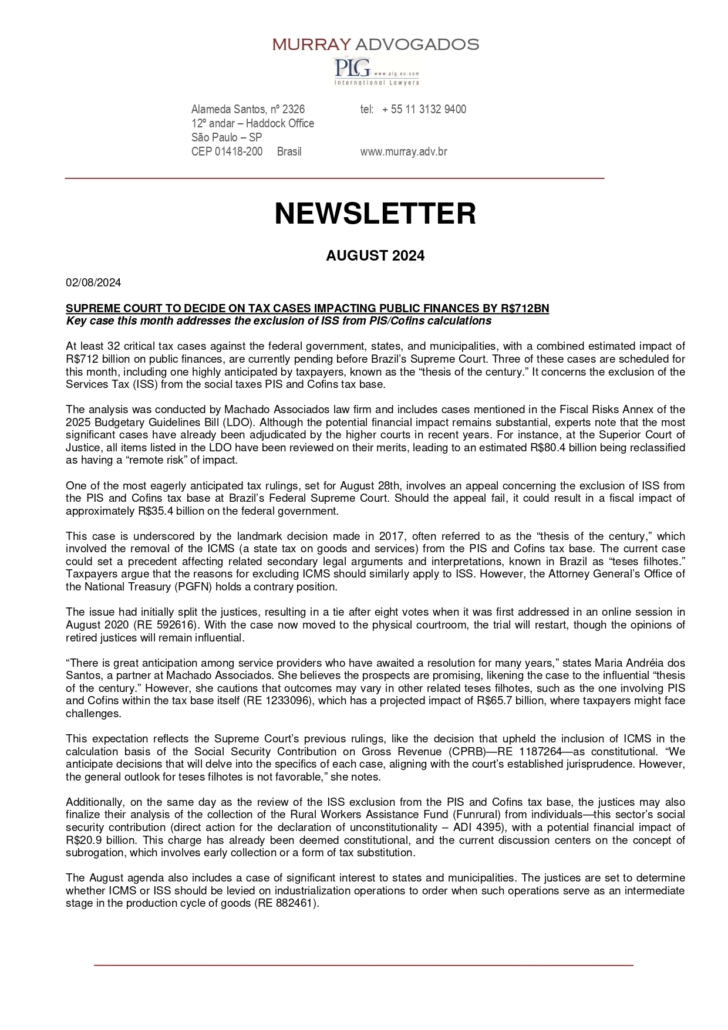
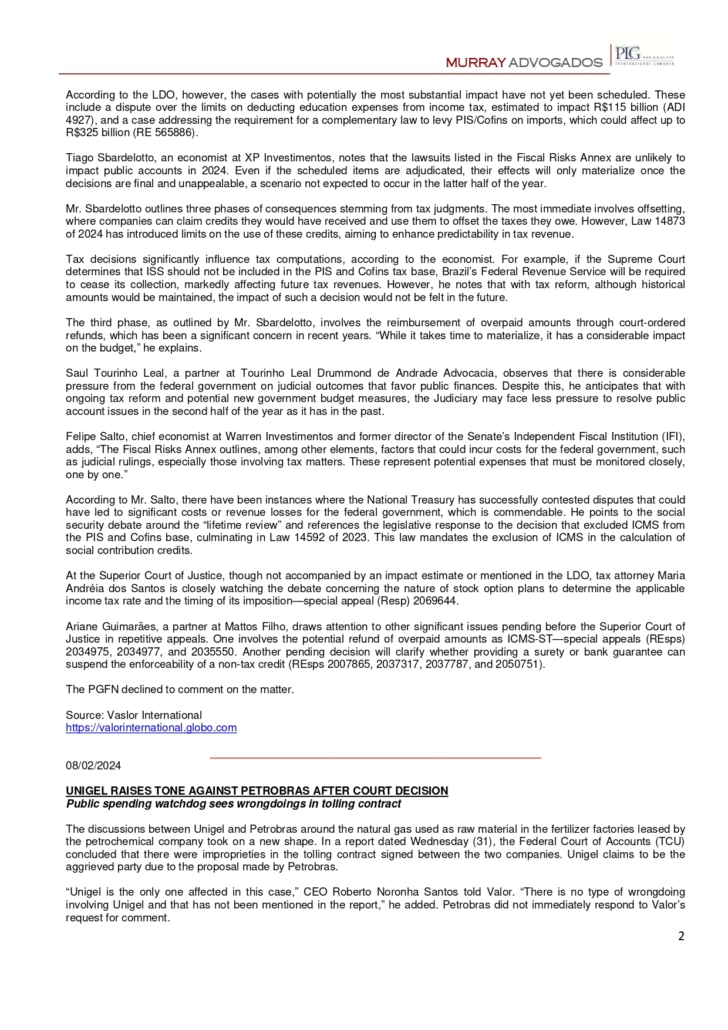
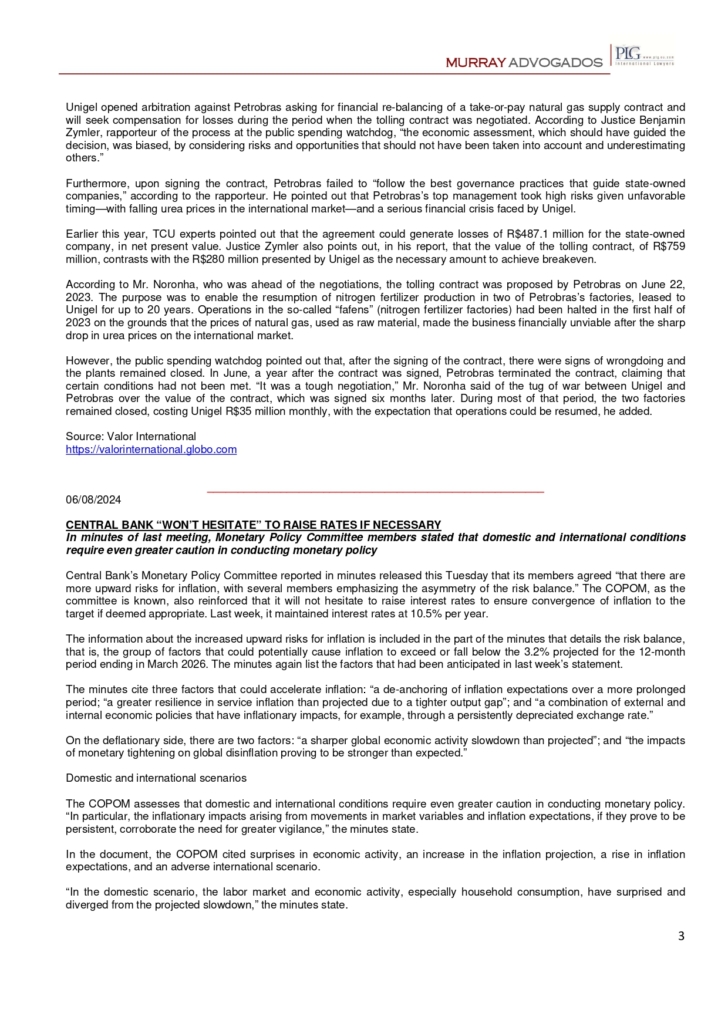


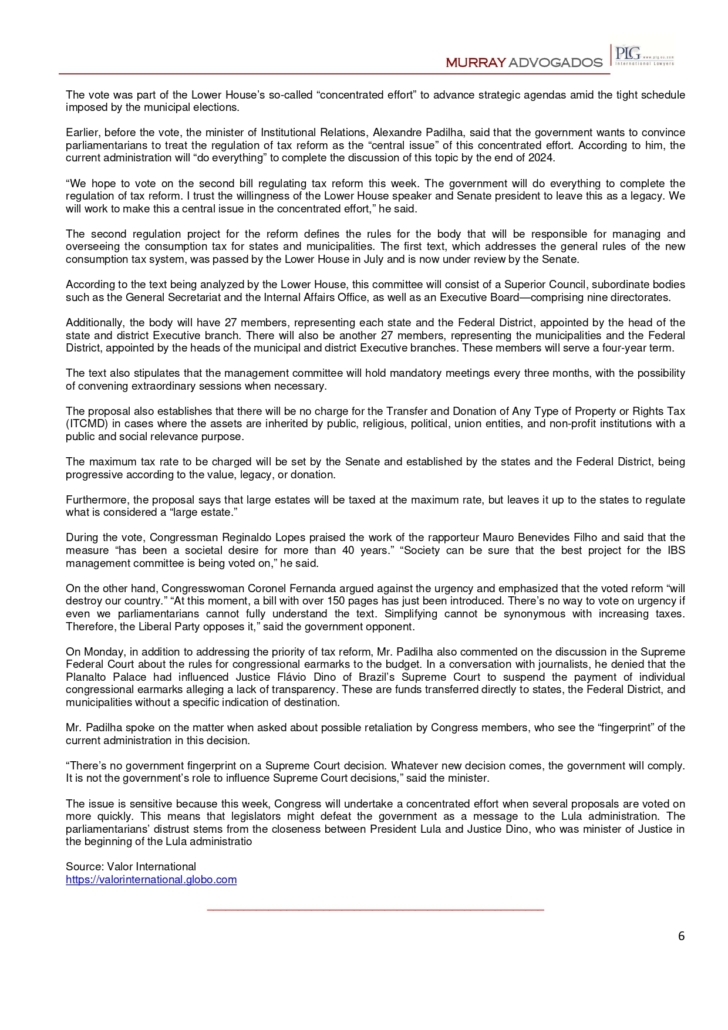
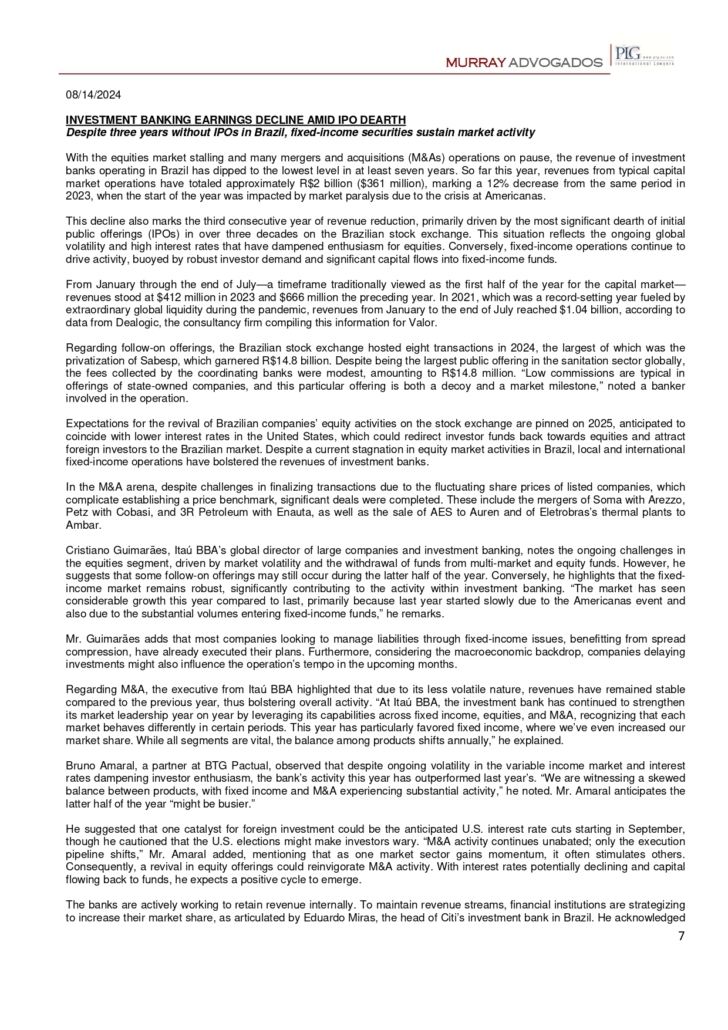
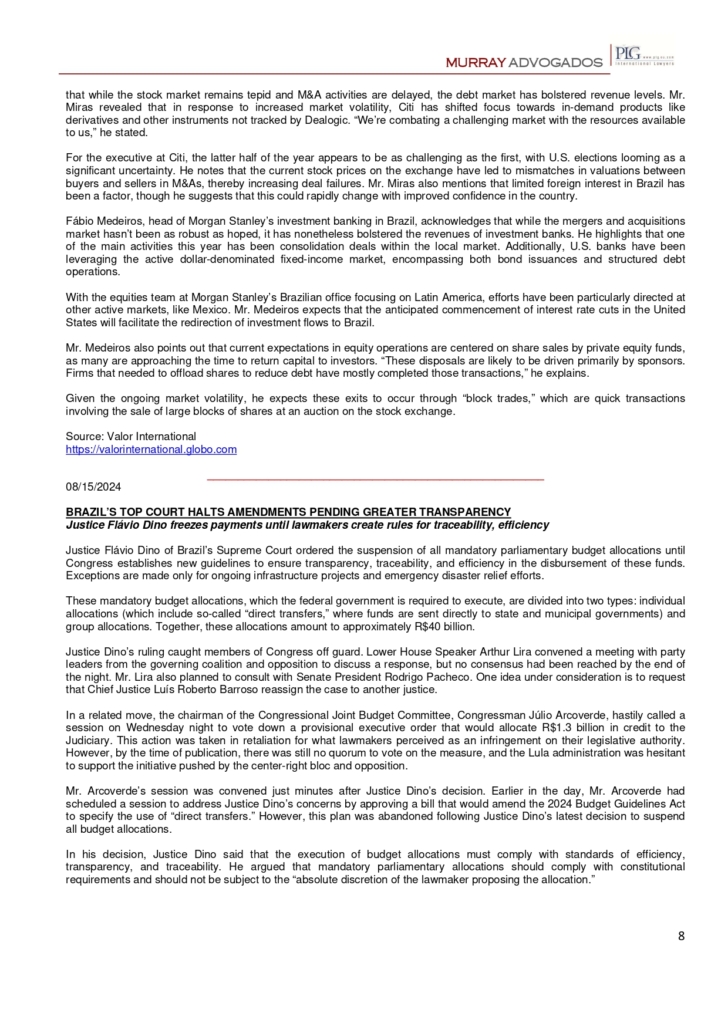
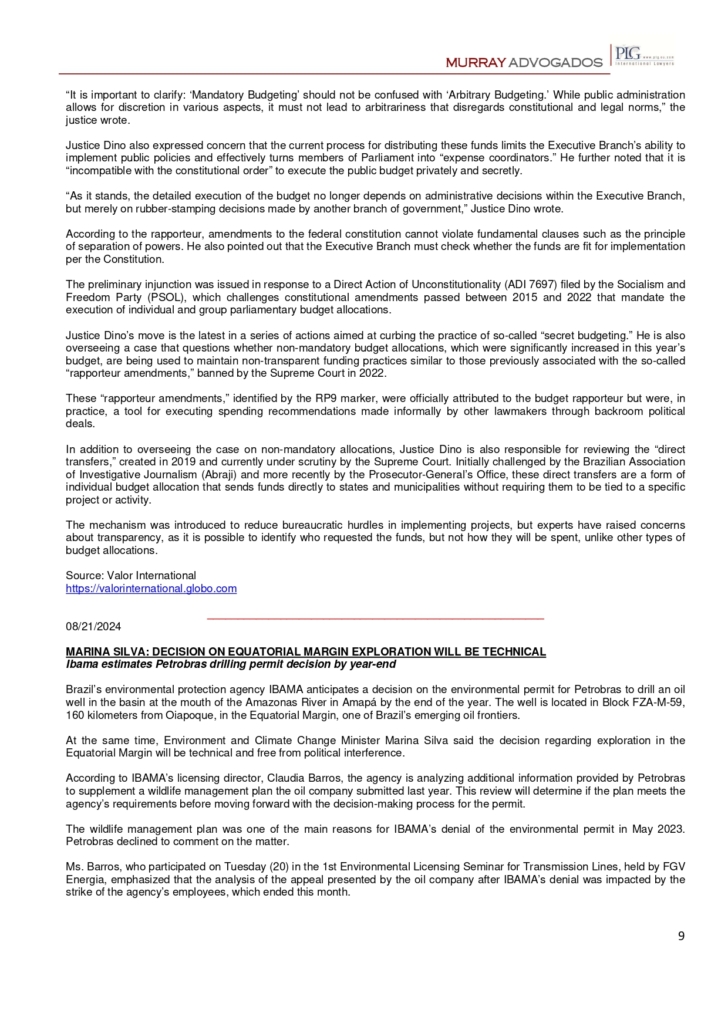
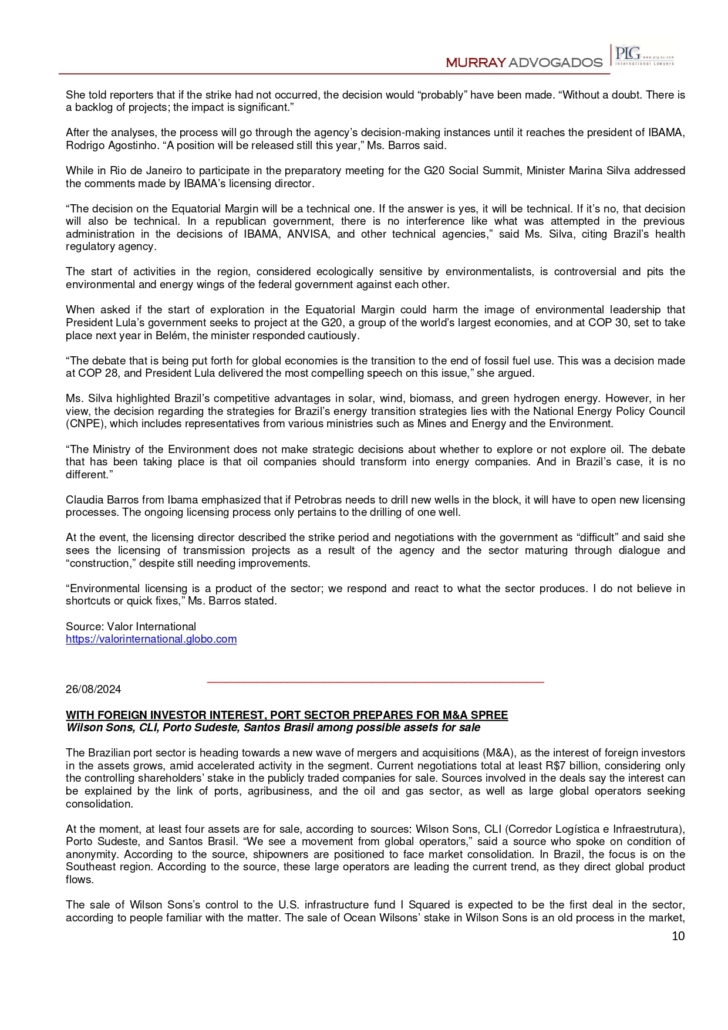
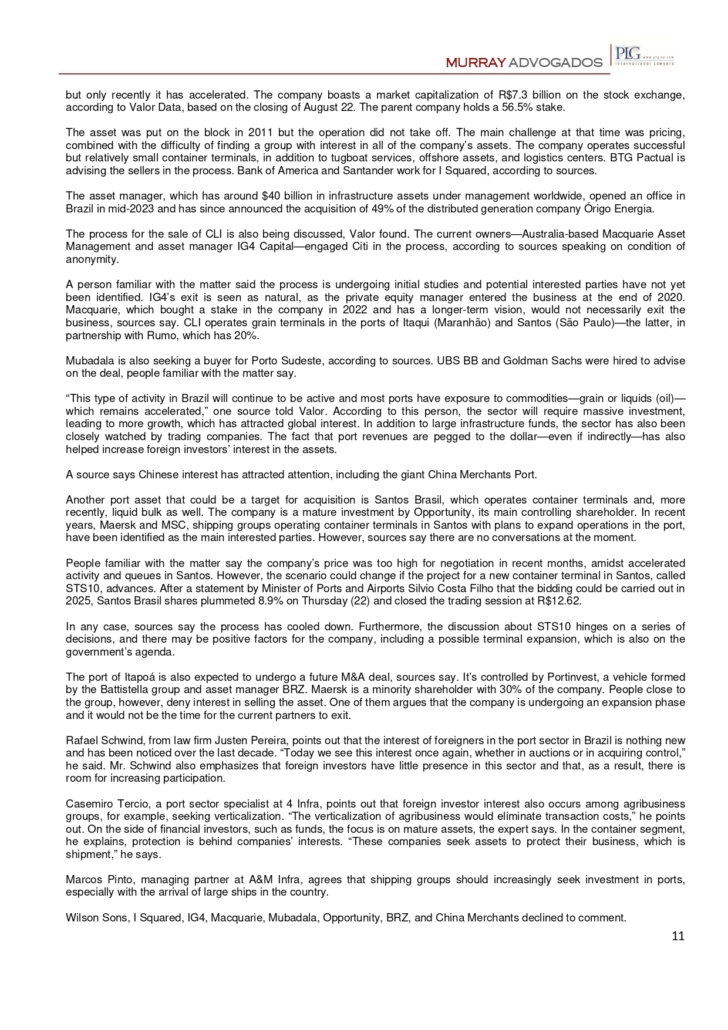

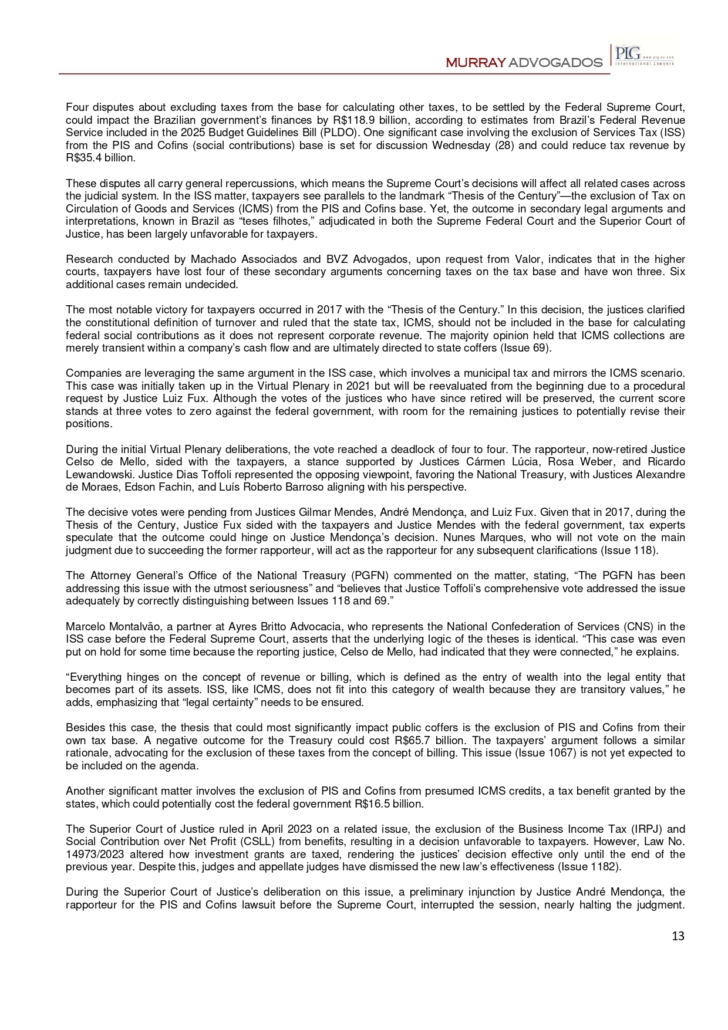
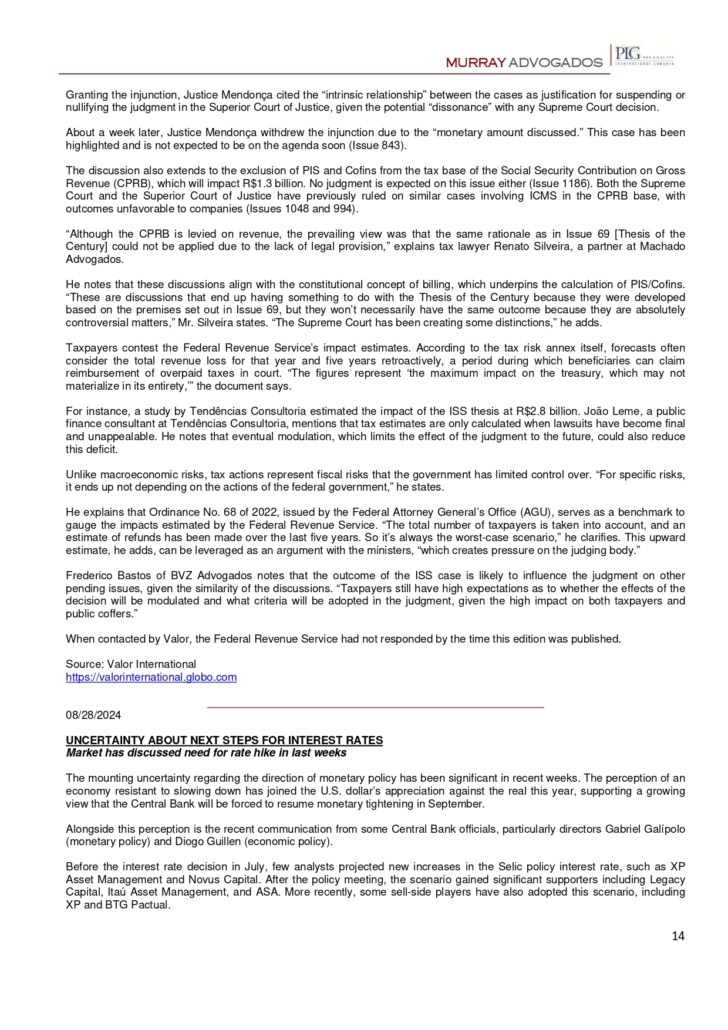
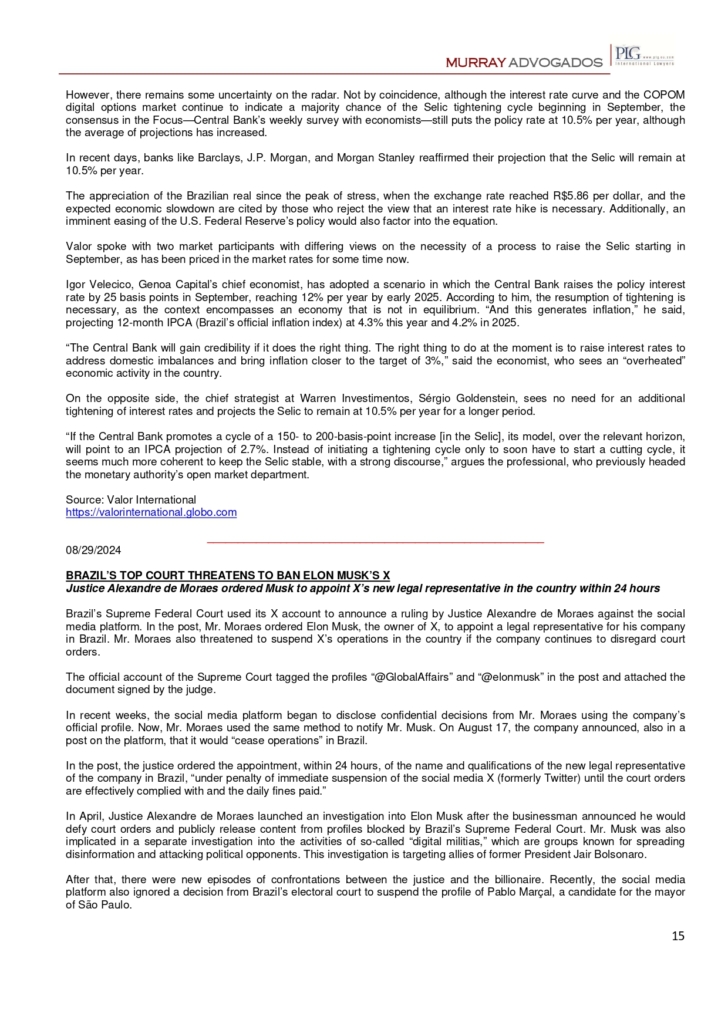
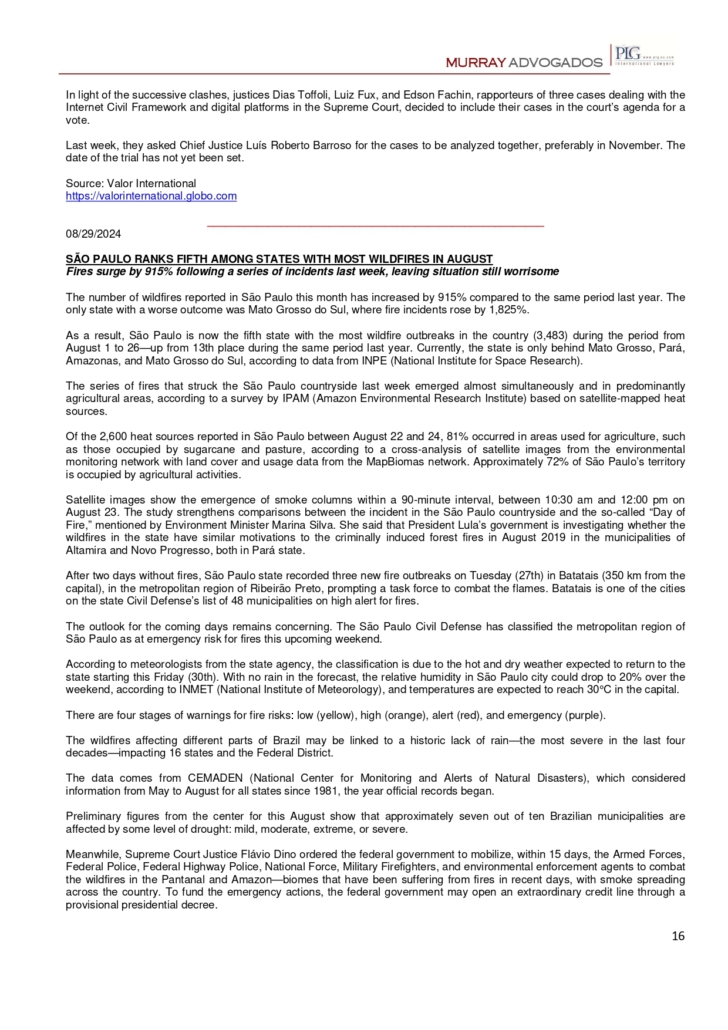
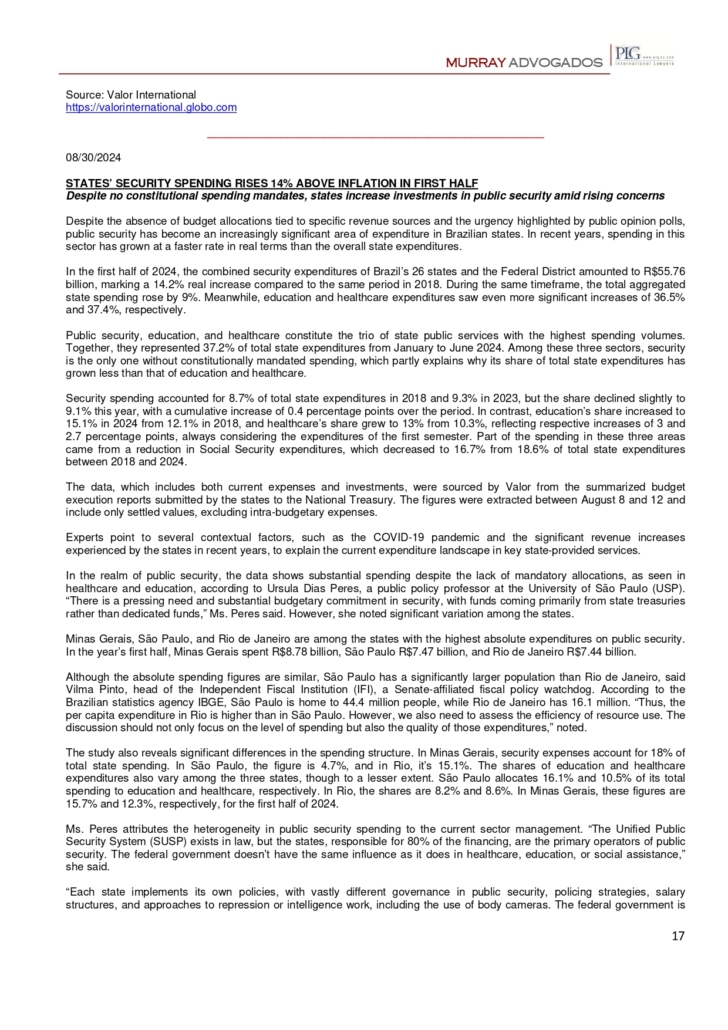
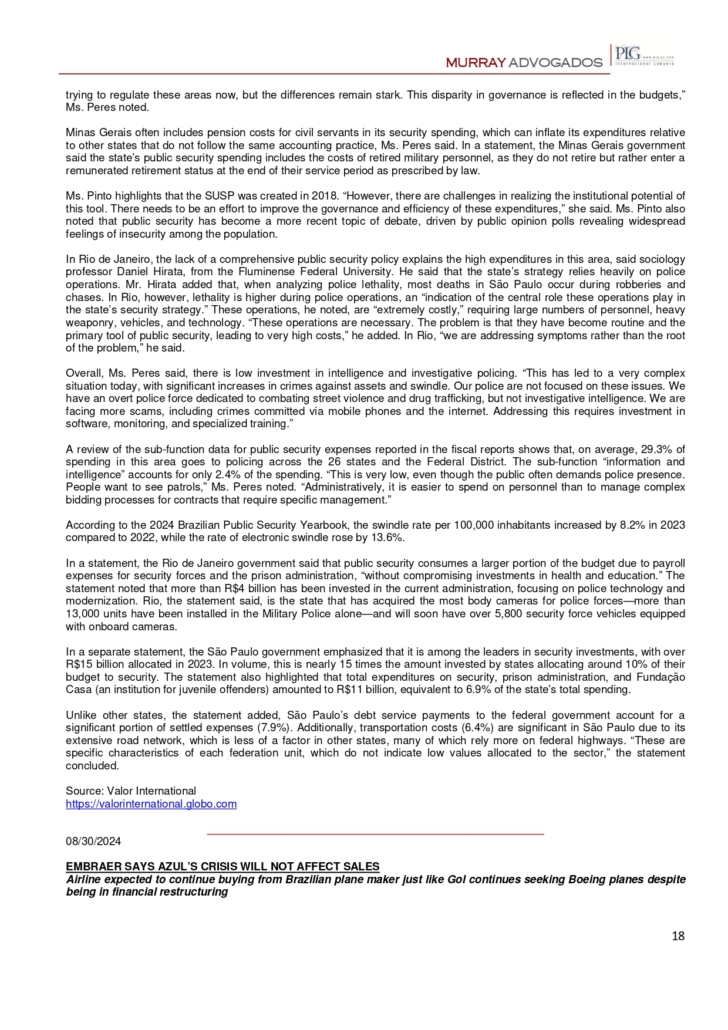

MURRAY ADVOGADOS



















08/30/2024
Azul’s financial restructuring is unlikely to affect Embraer’s sales, said Antonio Carlos Garcia, the plane maker’s chief financial officer. David Neeleman’s Azul is the only airline currently operating Embraer’s commercial models in Brazil but, according to Mr. Garcia, it continues to buy planes, and will keep doing so just as competitor Gol continues to seek Boeing planes despite its ongoing financial restructuring in the U.S.
At an event at B3 to mark Embraer’s 35 years of stock exchange listing, Mr. Garcia praised the company’s partnership with Azul. “They take planes from leasing companies. We already know that the lessors will continue to extend credit to Azul, just as they do for Gol. We have a lot of confidence in Azul’s business model. Things are more complicated for them, but we think they will pull through,” he said.
Regarding the aircraft manufacturer’s performance, CEO Francisco Gomes Neto stated that the next five years would be positive due to strong demand for its planes. “Our order book has surpassed $21 billion, which accounts for more than three years of production. And we have several sales campaigns underway,” he said.
The executive recalled that Embraer faced various challenges in recent years, including the pandemic and the failure of negotiations to create a joint venture in the commercial division with Boeing. “The year 2020 was difficult, with enormous losses. But one year later, at the end of 2021, the cash flow, which was negative by R$900 million, turned positive by R$300 million. The losses turned into profits,” he said.
Similarly, margins began to recover. Rodrigo Silva e Souza, vice president of marketing and market strategy for Embraer’s commercial aviation, highlighted that since last year, the company has had better margins on aircraft sales due to a change in discount policy.
“In new sales since last year, we have been working to increase profitability and capitalize on favorable market conditions. Therefore, I believe that in 2026 and 2027, we should significantly improve profitability,” he said during the event on Thursday (29).
According to the executive, the discount policy was designed considering various factors, including the pandemic, the end of the agreement with Boeing, and Airbus’s acquisition of Bombardier’s C-Series jet program (now A220).
“These factors made us have to be more aggressive to keep the company afloat during critical years. This has already changed due to strong market demand. We no longer need to be as aggressive as before. We have basically sold out the 2025 line and a good part of 2026,” he noted. According to Mr. Souza, Embraer expects to reach 2026 producing 100 commercial planes per year.
The government’s decision to release credit to airlines using the National Civil Aviation Fund (FNAC) as a guarantor, but without the obligation to use it to purchase Embraer aircraft, did not shake the Brazilian manufacturer.
“We do not rely on mandatory customer purchases. We do see that the Brazilian market—like others—needs more connectivity,” said Mr. Souza.
“If we take two of the largest regions, São Paulo and Rio, they represent 40% of the traffic. It is a concentrated market that needs to be decentralized and new routes developed,” he said. The use of smaller aircraft, such as Embraer’s commercial jets, would be central to this strategy.
CEO Francisco Gomes Neto praised the Brazilian government for the support it has offered the company. “The perspective they have is that in other countries where planes are produced, the percentage of national production flying is 40%. Here, it is only 12%. We have only one airline with Embraer jets,” he said.
*Por Cristian Favaro — São Paulo
Source: Valor International
08/30/2024
/i.s3.glbimg.com/v1/AUTH_63b422c2caee4269b8b34177e8876b93/internal_photos/bs/2024/J/p/Nkj2s9Rv6Sofntml3odQ/foto30bra-101-segura-a4.jpg)
Ursula Dias Peres — Foto: Silvia Zamboni/Valor
Despite the absence of budget allocations tied to specific revenue sources and the urgency highlighted by public opinion polls, public security has become an increasingly significant area of expenditure in Brazilian states. In recent years, spending in this sector has grown at a faster rate in real terms than the overall state expenditures.
In the first half of 2024, the combined security expenditures of Brazil’s 26 states and the Federal District amounted to R$55.76 billion, marking a 14.2% real increase compared to the same period in 2018. During the same timeframe, the total aggregated state spending rose by 9%. Meanwhile, education and healthcare expenditures saw even more significant increases of 36.5% and 37.4%, respectively.
Public security, education, and healthcare constitute the trio of state public services with the highest spending volumes. Together, they represented 37.2% of total state expenditures from January to June 2024. Among these three sectors, security is the only one without constitutionally mandated spending, which partly explains why its share of total state expenditures has grown less than that of education and healthcare.
Security spending accounted for 8.7% of total state expenditures in 2018 and 9.3% in 2023, but the share declined slightly to 9.1% this year, with a cumulative increase of 0.4 percentage points over the period. In contrast, education’s share increased to 15.1% in 2024 from 12.1% in 2018, and healthcare’s share grew to 13% from 10.3%, reflecting respective increases of 3 and 2.7 percentage points, always considering the expenditures of the first semester. Part of the spending in these three areas came from a reduction in Social Security expenditures, which decreased to 16.7% from 18.6% of total state expenditures between 2018 and 2024.
The data, which includes both current expenses and investments, were sourced by Valor from the summarized budget execution reports submitted by the states to the National Treasury. The figures were extracted between August 8 and 12 and include only settled values, excluding intra-budgetary expenses.
Experts point to several contextual factors, such as the COVID-19 pandemic and the significant revenue increases experienced by the states in recent years, to explain the current expenditure landscape in key state-provided services.
In the realm of public security, the data shows substantial spending despite the lack of mandatory allocations, as seen in healthcare and education, according to Ursula Dias Peres, a public policy professor at the University of São Paulo (USP). “There is a pressing need and substantial budgetary commitment in security, with funds coming primarily from state treasuries rather than dedicated funds,” Ms. Peres said. However, she noted significant variation among the states.
Minas Gerais, São Paulo, and Rio de Janeiro are among the states with the highest absolute expenditures on public security. In the year’s first half, Minas Gerais spent R$8.78 billion, São Paulo R$7.47 billion, and Rio de Janeiro R$7.44 billion.
Although the absolute spending figures are similar, São Paulo has a significantly larger population than Rio de Janeiro, said Vilma Pinto, head of the Independent Fiscal Institution (IFI), a Senate-affiliated fiscal policy watchdog. According to the Brazilian statistics agency IBGE, São Paulo is home to 44.4 million people, while Rio de Janeiro has 16.1 million. “Thus, the per capita expenditure in Rio is higher than in São Paulo. However, we also need to assess the efficiency of resource use. The discussion should not only focus on the level of spending but also the quality of those expenditures,” noted.
The study also reveals significant differences in the spending structure. In Minas Gerais, security expenses account for 18% of total state spending. In São Paulo, the figure is 4.7%, and in Rio, it’s 15.1%. The shares of education and healthcare expenditures also vary among the three states, though to a lesser extent. São Paulo allocates 16.1% and 10.5% of its total spending to education and healthcare, respectively. In Rio, the shares are 8.2% and 8.6%. In Minas Gerais, these figures are 15.7% and 12.3%, respectively, for the first half of 2024.
Ms. Peres attributes the heterogeneity in public security spending to the current sector management. “The Unified Public Security System (SUSP) exists in law, but the states, responsible for 80% of the financing, are the primary operators of public security. The federal government doesn’t have the same influence as it does in healthcare, education, or social assistance,” she said.
“Each state implements its own policies, with vastly different governance in public security, policing strategies, salary structures, and approaches to repression or intelligence work, including the use of body cameras. The federal government is trying to regulate these areas now, but the differences remain stark. This disparity in governance is reflected in the budgets,” Ms. Peres noted.
Minas Gerais often includes pension costs for civil servants in its security spending, which can inflate its expenditures relative to other states that do not follow the same accounting practice, Ms. Peres said. In a statement, the Minas Gerais government said the state’s public security spending includes the costs of retired military personnel, as they do not retire but rather enter a remunerated retirement status at the end of their service period as prescribed by law.
Ms. Pinto highlights that the SUSP was created in 2018. “However, there are challenges in realizing the institutional potential of this tool. There needs to be an effort to improve the governance and efficiency of these expenditures,” she said. Ms. Pinto also noted that public security has become a more recent topic of debate, driven by public opinion polls revealing widespread feelings of insecurity among the population.
In Rio de Janeiro, the lack of a comprehensive public security policy explains the high expenditures in this area, said sociology professor Daniel Hirata, from the Fluminense Federal University. He said that the state’s strategy relies heavily on police operations. Mr. Hirata added that, when analyzing police lethality, most deaths in São Paulo occur during robberies and chases. In Rio, however, lethality is higher during police operations, an “indication of the central role these operations play in the state’s security strategy.” These operations, he noted, are “extremely costly,” requiring large numbers of personnel, heavy weaponry, vehicles, and technology. “These operations are necessary. The problem is that they have become routine and the primary tool of public security, leading to very high costs,” he added. In Rio, “we are addressing symptoms rather than the root of the problem,” he said.
Overall, Ms. Peres said, there is low investment in intelligence and investigative policing. “This has led to a very complex situation today, with significant increases in crimes against assets and swindle. Our police are not focused on these issues. We have an overt police force dedicated to combating street violence and drug trafficking, but not investigative intelligence. We are facing more scams, including crimes committed via mobile phones and the internet. Addressing this requires investment in software, monitoring, and specialized training.”
A review of the sub-function data for public security expenses reported in the fiscal reports shows that, on average, 29.3% of spending in this area goes to policing across the 26 states and the Federal District. The sub-function “information and intelligence” accounts for only 2.4% of the spending. “This is very low, even though the public often demands police presence. People want to see patrols,” Ms. Peres noted. “Administratively, it is easier to spend on personnel than to manage complex bidding processes for contracts that require specific management.”
According to the 2024 Brazilian Public Security Yearbook, the swindle rate per 100,000 inhabitants increased by 8.2% in 2023 compared to 2022, while the rate of electronic swindle rose by 13.6%.
In a statement, the Rio de Janeiro government said that public security consumes a larger portion of the budget due to payroll expenses for security forces and the prison administration, “without compromising investments in health and education.” The statement noted that more than R$4 billion has been invested in the current administration, focusing on police technology and modernization. Rio, the statement said, is the state that has acquired the most body cameras for police forces—more than 13,000 units have been installed in the Military Police alone—and will soon have over 5,800 security force vehicles equipped with onboard cameras.
In a separate statement, the São Paulo government emphasized that it is among the leaders in security investments, with over R$15 billion allocated in 2023. In volume, this is nearly 15 times the amount invested by states allocating around 10% of their budget to security. The statement also highlighted that total expenditures on security, prison administration, and Fundação Casa (an institution for juvenile offenders) amounted to R$11 billion, equivalent to 6.9% of the state’s total spending.
Unlike other states, the statement added, São Paulo’s debt service payments to the federal government account for a significant portion of settled expenses (7.9%). Additionally, transportation costs (6.4%) are significant in São Paulo due to its extensive road network, which is less of a factor in other states, many of which rely more on federal highways. “These are specific characteristics of each federation unit, which do not indicate low values allocated to the sector,” the statement concluded.
*Por Marta Watanabe, Rafael Rosas — São Paulo, Rio de Janeiro
Source: Valor International
08/29/2024
The number of wildfires reported in São Paulo this month has increased by 915% compared to the same period last year. The only state with a worse outcome was Mato Grosso do Sul, where fire incidents rose by 1,825%.
As a result, São Paulo is now the fifth state with the most wildfire outbreaks in the country (3,483) during the period from August 1 to 26—up from 13th place during the same period last year. Currently, the state is only behind Mato Grosso, Pará, Amazonas, and Mato Grosso do Sul, according to data from INPE (National Institute for Space Research).
The series of fires that struck the São Paulo countryside last week emerged almost simultaneously and in predominantly agricultural areas, according to a survey by IPAM (Amazon Environmental Research Institute) based on satellite-mapped heat sources.
Of the 2,600 heat sources reported in São Paulo between August 22 and 24, 81% occurred in areas used for agriculture, such as those occupied by sugarcane and pasture, according to a cross-analysis of satellite images from the environmental monitoring network with land cover and usage data from the MapBiomas network. Approximately 72% of São Paulo’s territory is occupied by agricultural activities.
Satellite images show the emergence of smoke columns within a 90-minute interval, between 10:30 am and 12:00 pm on August 23. The study strengthens comparisons between the incident in the São Paulo countryside and the so-called “Day of Fire,” mentioned by Environment Minister Marina Silva. She said that President Lula’s government is investigating whether the wildfires in the state have similar motivations to the criminally induced forest fires in August 2019 in the municipalities of Altamira and Novo Progresso, both in Pará state.
After two days without fires, São Paulo state recorded three new fire outbreaks on Tuesday (27th) in Batatais (350 km from the capital), in the metropolitan region of Ribeirão Preto, prompting a task force to combat the flames. Batatais is one of the cities on the state Civil Defense’s list of 48 municipalities on high alert for fires.
The outlook for the coming days remains concerning. The São Paulo Civil Defense has classified the metropolitan region of São Paulo as at emergency risk for fires this upcoming weekend.
According to meteorologists from the state agency, the classification is due to the hot and dry weather expected to return to the state starting this Friday (30th). With no rain in the forecast, the relative humidity in São Paulo city could drop to 20% over the weekend, according to INMET (National Institute of Meteorology), and temperatures are expected to reach 30°C in the capital.
There are four stages of warnings for fire risks: low (yellow), high (orange), alert (red), and emergency (purple).
The wildfires affecting different parts of Brazil may be linked to a historic lack of rain—the most severe in the last four decades—impacting 16 states and the Federal District.
The data comes from CEMADEN (National Center for Monitoring and Alerts of Natural Disasters), which considered information from May to August for all states since 1981, the year official records began.
Preliminary figures from the center for this August show that approximately seven out of ten Brazilian municipalities are affected by some level of drought: mild, moderate, extreme, or severe.
Meanwhile, Supreme Court Justice Flávio Dino ordered the federal government to mobilize, within 15 days, the Armed Forces, Federal Police, Federal Highway Police, National Force, Military Firefighters, and environmental enforcement agents to combat the wildfires in the Pantanal and Amazon—biomes that have been suffering from fires in recent days, with smoke spreading across the country. To fund the emergency actions, the federal government may open an extraordinary credit line through a provisional presidential decree.
Source: Valor International
08/29/2024
/i.s3.glbimg.com/v1/AUTH_37554604729d4b2f9f3eb9ad8a691345/internal_photos/bs/2024/T/b/X7bhDBS1mTLV83rlQN9g/53630248813-d0fe4eaa81-o.jpg)
Alexandre de Moraes — Foto: Rosinei Coutinho/SCO/STF
Brazil’s Supreme Federal Court used its X account to announce a ruling by Justice Alexandre de Moraes against the social media platform. In the post, Mr. Moraes ordered Elon Musk, the owner of X, to appoint a legal representative for his company in Brazil. Mr. Moraes also threatened to suspend X’s operations in the country if the company continues to disregard court orders.
The official account of the Supreme Court tagged the profiles “@GlobalAffairs” and “@elonmusk” in the post and attached the document signed by the judge.
In recent weeks, the social media platform began to disclose confidential decisions from Mr. Moraes using the company’s official profile. Now, Mr. Moraes used the same method to notify Mr. Musk. On August 17, the company announced, also in a post on the platform, that it would “cease operations” in Brazil.
In the post, the justice ordered the appointment, within 24 hours, of the name and qualifications of the new legal representative of the company in Brazil, “under penalty of immediate suspension of the social media X (formerly Twitter) until the court orders are effectively complied with and the daily fines paid.”
In April, Justice Alexandre de Moraes launched an investigation into Elon Musk after the businessman announced he would defy court orders and publicly release content from profiles blocked by Brazil’s Supreme Federal Court. Mr. Musk was also implicated in a separate investigation into the activities of so-called “digital militias,” which are groups known for spreading disinformation and attacking political opponents. This investigation is targeting allies of former President Jair Bolsonaro.
After that, there were new episodes of confrontations between the justice and the billionaire. Recently, the social media platform also ignored a decision from Brazil’s electoral court to suspend the profile of Pablo Marçal, a candidate for the mayor of São Paulo.
In light of the successive clashes, justices Dias Toffoli, Luiz Fux, and Edson Fachin, rapporteurs of three cases dealing with the Internet Civil Framework and digital platforms in the Supreme Court, decided to include their cases in the court’s agenda for a vote.
Last week, they asked Chief Justice Luís Roberto Barroso for the cases to be analyzed together, preferably in November. The date of the trial has not yet been set.
*Por Isadora Peron — Brasília
Source: Valor International
08/28/2024
/i.s3.glbimg.com/v1/AUTH_37554604729d4b2f9f3eb9ad8a691345/internal_photos/bs/2022/A/C/ca4EU0SmmtYocd4v6EAg/280521genoa30.jpg)
Igor Velecico — Foto: Silvia Costanti/Valor
The mounting uncertainty regarding the direction of monetary policy has been significant in recent weeks. The perception of an economy resistant to slowing down has joined the U.S. dollar’s appreciation against the real this year, supporting a growing view that the Central Bank will be forced to resume monetary tightening in September.
Alongside this perception is the recent communication from some Central Bank officials, particularly directors Gabriel Galípolo (monetary policy) and Diogo Guillen (economic policy).
Before the interest rate decision in July, few analysts projected new increases in the Selic policy interest rate, such as XP Asset Management and Novus Capital. After the policy meeting, the scenario gained significant supporters including Legacy Capital, Itaú Asset Management, and ASA. More recently, some sell-side players have also adopted this scenario, including XP and BTG Pactual.
However, there remains some uncertainty on the radar. Not by coincidence, although the interest rate curve and the COPOM digital options market continue to indicate a majority chance of the Selic tightening cycle beginning in September, the consensus in the Focus—Central Bank’s weekly survey with economists—still puts the policy rate at 10.5% per year, although the average of projections has increased.
In recent days, banks like Barclays, J.P. Morgan, and Morgan Stanley reaffirmed their projection that the Selic will remain at 10.5% per year.
The appreciation of the Brazilian real since the peak of stress, when the exchange rate reached R$5.86 per dollar, and the expected economic slowdown are cited by those who reject the view that an interest rate hike is necessary. Additionally, an imminent easing of the U.S. Federal Reserve’s policy would also factor into the equation.
Valor spoke with two market participants with differing views on the necessity of a process to raise the Selic starting in September, as has been priced in the market rates for some time now.
Igor Velecico, Genoa Capital’s chief economist, has adopted a scenario in which the Central Bank raises the policy interest rate by 25 basis points in September, reaching 12% per year by early 2025. According to him, the resumption of tightening is necessary, as the context encompasses an economy that is not in equilibrium. “And this generates inflation,” he said, projecting 12-month IPCA (Brazil’s official inflation index) at 4.3% this year and 4.2% in 2025.
“The Central Bank will gain credibility if it does the right thing. The right thing to do at the moment is to raise interest rates to address domestic imbalances and bring inflation closer to the target of 3%,” said the economist, who sees an “overheated” economic activity in the country.
On the opposite side, the chief strategist at Warren Investimentos, Sérgio Goldenstein, sees no need for an additional tightening of interest rates and projects the Selic to remain at 10.5% per year for a longer period.
“If the Central Bank promotes a cycle of a 150- to 200-basis-point increase [in the Selic], its model, over the relevant horizon, will point to an IPCA projection of 2.7%. Instead of initiating a tightening cycle only to soon have to start a cutting cycle, it seems much more coherent to keep the Selic stable, with a strong discourse,” argues the professional, who previously headed the monetary authority’s open market department.
*Por Gabriel Roca, Victor Rezende — São Paulo
Source: Valor International
08/28/2024
/i.s3.glbimg.com/v1/AUTH_37554604729d4b2f9f3eb9ad8a691345/internal_photos/bs/2024/A/B/Sgax7BQBqezaAjOmaAlQ/marcelo-montalvao-advogado-credito-divulgacao.png)
Marcelo Montalvão — Foto: Divulgação
Four disputes about excluding taxes from the base for calculating other taxes, to be settled by the Federal Supreme Court, could impact the Brazilian government’s finances by R$118.9 billion, according to estimates from Brazil’s Federal Revenue Service included in the 2025 Budget Guidelines Bill (PLDO). One significant case involving the exclusion of Services Tax (ISS) from the PIS and Cofins (social contributions) base is set for discussion Wednesday (28) and could reduce tax revenue by R$35.4 billion.
These disputes all carry general repercussions, which means the Supreme Court’s decisions will affect all related cases across the judicial system. In the ISS matter, taxpayers see parallels to the landmark “Thesis of the Century”—the exclusion of Tax on Circulation of Goods and Services (ICMS) from the PIS and Cofins base. Yet, the outcome in secondary legal arguments and interpretations, known in Brazil as “teses filhotes,” adjudicated in both the Supreme Federal Court and the Superior Court of Justice, has been largely unfavorable for taxpayers.
Research conducted by Machado Associados and BVZ Advogados, upon request from Valor, indicates that in the higher courts, taxpayers have lost four of these secondary arguments concerning taxes on the tax base and have won three. Six additional cases remain undecided.
The most notable victory for taxpayers occurred in 2017 with the “Thesis of the Century.” In this decision, the justices clarified the constitutional definition of turnover and ruled that the state tax, ICMS, should not be included in the base for calculating federal social contributions as it does not represent corporate revenue. The majority opinion held that ICMS collections are merely transient within a company’s cash flow and are ultimately directed to state coffers (Issue 69).
Companies are leveraging the same argument in the ISS case, which involves a municipal tax and mirrors the ICMS scenario. This case was initially taken up in the Virtual Plenary in 2021 but will be reevaluated from the beginning due to a procedural request by Justice Luiz Fux. Although the votes of the justices who have since retired will be preserved, the current score stands at three votes to zero against the federal government, with room for the remaining justices to potentially revise their positions.
During the initial Virtual Plenary deliberations, the vote reached a deadlock of four to four. The rapporteur, now-retired Justice Celso de Mello, sided with the taxpayers, a stance supported by Justices Cármen Lúcia, Rosa Weber, and Ricardo Lewandowski. Justice Dias Toffoli represented the opposing viewpoint, favoring the National Treasury, with Justices Alexandre de Moraes, Edson Fachin, and Luís Roberto Barroso aligning with his perspective.
The decisive votes were pending from Justices Gilmar Mendes, André Mendonça, and Luiz Fux. Given that in 2017, during the Thesis of the Century, Justice Fux sided with the taxpayers and Justice Mendes with the federal government, tax experts speculate that the outcome could hinge on Justice Mendonça’s decision. Nunes Marques, who will not vote on the main judgment due to succeeding the former rapporteur, will act as the rapporteur for any subsequent clarifications (Issue 118).
The Attorney General’s Office of the National Treasury (PGFN) commented on the matter, stating, “The PGFN has been addressing this issue with the utmost seriousness” and “believes that Justice Toffoli’s comprehensive vote addressed the issue adequately by correctly distinguishing between Issues 118 and 69.”
Marcelo Montalvão, a partner at Ayres Britto Advocacia, who represents the National Confederation of Services (CNS) in the ISS case before the Federal Supreme Court, asserts that the underlying logic of the theses is identical. “This case was even put on hold for some time because the reporting justice, Celso de Mello, had indicated that they were connected,” he explains.
“Everything hinges on the concept of revenue or billing, which is defined as the entry of wealth into the legal entity that becomes part of its assets. ISS, like ICMS, does not fit into this category of wealth because they are transitory values,” he adds, emphasizing that “legal certainty” needs to be ensured.
Besides this case, the thesis that could most significantly impact public coffers is the exclusion of PIS and Cofins from their own tax base. A negative outcome for the Treasury could cost R$65.7 billion. The taxpayers’ argument follows a similar rationale, advocating for the exclusion of these taxes from the concept of billing. This issue (Issue 1067) is not yet expected to be included on the agenda.
Another significant matter involves the exclusion of PIS and Cofins from presumed ICMS credits, a tax benefit granted by the states, which could potentially cost the federal government R$16.5 billion.
The Superior Court of Justice ruled in April 2023 on a related issue, the exclusion of the Business Income Tax (IRPJ) and Social Contribution over Net Profit (CSLL) from benefits, resulting in a decision unfavorable to taxpayers. However, Law No. 14973/2023 altered how investment grants are taxed, rendering the justices’ decision effective only until the end of the previous year. Despite this, judges and appellate judges have dismissed the new law’s effectiveness (Issue 1182).
During the Superior Court of Justice’s deliberation on this issue, a preliminary injunction by Justice André Mendonça, the rapporteur for the PIS and Cofins lawsuit before the Supreme Court, interrupted the session, nearly halting the judgment. Granting the injunction, Justice Mendonça cited the “intrinsic relationship” between the cases as justification for suspending or nullifying the judgment in the Superior Court of Justice, given the potential “dissonance” with any Supreme Court decision.
About a week later, Justice Mendonça withdrew the injunction due to the “monetary amount discussed.” This case has been highlighted and is not expected to be on the agenda soon (Issue 843).
The discussion also extends to the exclusion of PIS and Cofins from the tax base of the Social Security Contribution on Gross Revenue (CPRB), which will impact R$1.3 billion. No judgment is expected on this issue either (Issue 1186). Both the Supreme Court and the Superior Court of Justice have previously ruled on similar cases involving ICMS in the CPRB base, with outcomes unfavorable to companies (Issues 1048 and 994).
“Although the CPRB is levied on revenue, the prevailing view was that the same rationale as in Issue 69 [Thesis of the Century] could not be applied due to the lack of legal provision,” explains tax lawyer Renato Silveira, a partner at Machado Advogados.
He notes that these discussions align with the constitutional concept of billing, which underpins the calculation of PIS/Cofins. “These are discussions that end up having something to do with the Thesis of the Century because they were developed based on the premises set out in Issue 69, but they won’t necessarily have the same outcome because they are absolutely controversial matters,” Mr. Silveira states. “The Supreme Court has been creating some distinctions,” he adds.
Taxpayers contest the Federal Revenue Service’s impact estimates. According to the tax risk annex itself, forecasts often consider the total revenue loss for that year and five years retroactively, a period during which beneficiaries can claim reimbursement of overpaid taxes in court. “The figures represent ‘the maximum impact on the treasury, which may not materialize in its entirety,’” the document says.
For instance, a study by Tendências Consultoria estimated the impact of the ISS thesis at R$2.8 billion. João Leme, a public finance consultant at Tendências Consultoria, mentions that tax estimates are only calculated when lawsuits have become final and unappealable. He notes that eventual modulation, which limits the effect of the judgment to the future, could also reduce this deficit.
Unlike macroeconomic risks, tax actions represent fiscal risks that the government has limited control over. “For specific risks, it ends up not depending on the actions of the federal government,” he states.
He explains that Ordinance No. 68 of 2022, issued by the Federal Attorney General’s Office (AGU), serves as a benchmark to gauge the impacts estimated by the Federal Revenue Service. “The total number of taxpayers is taken into account, and an estimate of refunds has been made over the last five years. So it’s always the worst-case scenario,” he clarifies. This upward estimate, he adds, can be leveraged as an argument with the ministers, “which creates pressure on the judging body.”
Frederico Bastos of BVZ Advogados notes that the outcome of the ISS case is likely to influence the judgment on other pending issues, given the similarity of the discussions. “Taxpayers still have high expectations as to whether the effects of the decision will be modulated and what criteria will be adopted in the judgment, given the high impact on both taxpayers and public coffers.”
When contacted by Valor, the Federal Revenue Service had not responded by the time this edition was published.
*Por Marcela Villar — São Paulo
Source: Valor International
08/26/2024
/i.s3.glbimg.com/v1/AUTH_37554604729d4b2f9f3eb9ad8a691345/internal_photos/bs/2023/h/P/0P98ssRhuwskymF7hZVg/a81t2102.jpg)
Antonio Anastasia — Foto: José Cruz/Agência Brasil
As the Executive branch prepares to send the 2025 Annual Budget Act (PLOA) to Congress in about a week, Brazil’s public spending watchdog TCU has concluded that the government’s projection for next year’s primary balance carries significant risks. These risks stem from potential revenue shortfalls, increases in mandatory spending, and limitations on budgetary contingency measures.
The findings are detailed in a report by the TCU, which analyzed the 2025 Budget Guidelines Act (PLDO). The fiscal target for next year is zero deficit, with the PLDO forecasting a surplus of R$10.8 billion. The body’s plenary issued a warning with these findings to the economic team, with Antonio Anastasia serving as the rapporteur.
TCU auditors determined that the primary net revenue estimates presented in the PLDO are “optimistic,” exceeding market-based projections by R$35.6 billion to R$50.7 billion. This raises concerns about potential revenue shortfalls.
The technical team also noted that the projected increase in total primary expenditures exceeds the new fiscal framework’s limit of 2.5% real annual growth. This would compress discretionary spending, which includes public investment and operating costs.
The risk becomes even more pronounced in 2027 and 2028, according to the watchdog’s experts. During these years, projections for net discretionary spending, excluding congressional earmarks and minimum requirements, drop to R$11.75 billion in 2028 from R$100.94 billion in 2024—an 88% reduction over the period. This means there would be virtually no funds for investment or operational costs.
“Without legislative revision, the increase in mandatory expenses and expenditures tied proportionally to revenue could lead to a shutdown of government operations or compromise the fiscal anchor of the new framework,” the auditors said.
They also pointed out that while the 2025 PLDO includes measures to review expenditures, it lacks concrete proposals to amend legislation and address the risk of squeezing discretionary spending.
A third risk to meeting the fiscal target in 2025 arises from restrictions on budgetary cuts, should the zero-deficit target be threatened. The auditors noted that, under the new framework, the primary balance is allowed a tolerance range. The government has been targeting the lower bound of the target, rather than the midpoint, explicitly saying this in the 2025 PLDO.
The TCU has emphasized that aiming for the lower bound for cost-cutting purposes, while not illegal, could create “long-term inconsistencies in debt trajectory” and hinder the achievement of the fiscal target. The 2025 PLDO allows for a deficit of up to R$31 billion in 2025.
Another limitation on cost-cutting measures is the stipulation that only the portion of expenditure growth exceeding 0.6% in real terms may be frozen. The legality of this provision is under review by the TCU in a separate ongoing case.
“The scenario presented by the estimates will likely force the Executive branch to choose between two mutually exclusive options: either ensure the proper functioning of the federal administration or preserve the primary spending limit. Both appear to be incompatible under the projected scenario,” the TCU noted.
Finally, the TCU’s technical body said that the assumptions used by the government in the project—namely, spending growing at a slower pace than revenue and a rising primary balance starting in 2026—may be “unrealistic” without a revision of either mandatory or revenue-linked discretionary expenditures.
The ministries of Finance and Planning declined to comment.
*Por Jéssica Sant’Ana — Brasília
Source: Valor International
26/08/2024
/i.s3.glbimg.com/v1/AUTH_37554604729d4b2f9f3eb9ad8a691345/internal_photos/bs/2024/O/w/cByyNwQCaF9Wj7JK2yBA/5cb61ee1674646a2b9e46b462912d6b0-0-0930889e97514601925aaa9c098cfc3b.jpg)
Smoke from fires in the Amazon covered Brasília on Sunday — Foto: Eraldo Peres/AP
On Sunday, Environment Minister Marina Silva compared the fires in São Paulo to the “Day of Fire” in 2019. In light of suspicions that they may be the result of criminal actions, she has called in the Federal Police to investigate the origins of the fires that led 46 municipalities in the countryside of São Paulo to declare a maximum alert and close two airports in the state after covering the federal capital in smoke.
“There is an unusual situation [with the fires in São Paulo]. You start to see several municipalities burning at the same time, practically within a week, in just two days. This is not part of our experience,” said Ms. Silva. “Just as we had the ‘Day of Fire,’ there is a strong suspicion that it is happening again.” The so-called “Day of Fire” occurred in August 2019 when land-grabbers and rural producers coordinated efforts to set fire to areas of the Amazon rainforest.
“In São Paulo, it is not natural, under any circumstances, that in just a few days there would be so many fronts of fire and that so many fronts of fire would involve multiple municipalities at the same time,” Ms. Silva said at a press conference after a meeting with President Lula to assess the situation at the headquarters of Brazil’s environmental protection agency IBAMA in Brasília, which woke up covered in smoke from nearby fires and dry weather.
The Federal Police has opened two investigations to investigate possible criminal acts related to the fires. With these, the institution has 31 ongoing investigations regarding forest fires, with the previous ones relating to the Amazon rainforest and the Pantanal wetlands.
The head of the Federal Police, Andrei Rodrigues, said he has mobilized 15 police stations in São Paulo “so that we can identify the issues involving the fires.”
“It’s an unusual movement, but conclusions will only come with the completion of the police investigations,” he said. “There are two investigations in São Paulo looking into possible criminal fires, one has already been initiated,” he added, clarifying that both investigations concern the hypothesis of criminal fires and are separate “due to jurisdictional issues.”
The São Paulo government informed that two people were arrested over the weekend in the cities of São José do Rio Preto and Batatais on suspicion of involvement in criminal fires.
Ms. Silva said she spoke with Governor Tarcísio de Freitas of São Paulo about the fires. She also informed that the federal government has made a KC-390 cargo plane available to assist in fighting the fire, but the aircraft was unable to take off due to the smoke covering the Ribeirão Preto region in the countryside of the state.
Also present at the meeting with Mr. Lula, the minister of Institutional Relations, Alexandre Padilha, reinforced the government’s suspicions that there was a criminal action. “My grandmother used to say, ‘Where there’s smoke, there’s fire.’ If she were alive, she would say, ‘if there’s coordinated fire at the same time, in an unusual manner, there must be a crime,’” he said.
When asked about the federal government’s responsibility regarding the fires, Ms. Silva said that the situation would be much worse if the current administration had not been acting preventively since the government transition at the end of 2022. She also denied that there had been any failures.
“The federal government is responsible for federal areas and conservation units, but we are acting in all areas, including private properties. Unlike deforestation, you don’t have an agent inside your farm or house checking if a fire will be set. Therefore, it cannot be said that it is a failure, because awareness campaigns and all processes have been carried out,” she said. “The investigations are to determine if there is intentional action in the case of São Paulo. In other cases, there are strong suspicions of intentional action. [The situation in] São Paulo is also under investigation for that reason.”
The emergency meeting took place at the headquarters of Prevfogo (National Center for Prevention and Combat of Forest Fires), part of IBAMA. Besides Mr. Lula, Ms. Silva, the president of IBAMA, Rodrigo Agostinho, Mr. Padilha and Mr. Rodrigues were also present.
At Prevfogo, Mr. Lula and the ministers visited a situation room where IBAMA experts monitor the fires. The president, who had spent the night in São Paulo, landed early in the afternoon at the Brasília Air Base and went directly to the meeting accompanied by First Lady Rosângela da Silva.
According to Ms. Silva, Mr. Lula said he would participate in a routine meeting to monitor the fires, which takes place weekly at the Planalto Palace. He said he would call in governors of states affected by the fires. “[The president] expressed his decision to participate in the ordinary meeting, which is held every week in the Chief of Staff Office and involves more than 20 ministries. In this meeting, we will summon the governors of the states affected by the fires.”
In the countryside of São Paulo, the scene is one of chaos. With more than 2,300 fire incidents reported in two days, the state is at the top of fire occurrences in the country. The flames continue to advance in areas of vegetation and crops, especially in the Ribeirão Preto region.
The state government announced an increase in the operation to combat the fire in the countryside with the establishment of an advanced post in Ribeirão Preto. According to monitoring by the Emergency Management Center (CGE) of the Civil Defense, 21 cities are facing active fire fronts.
According to Governor Freitas, the unit will operate in an integrated manner with the crisis cabinet set up at the CGE for monitoring and controlling the situation. “Our task force consists of more than 7,000 professionals and volunteers, in addition to helicopters, drones, and vehicles to act in combating the fire and guiding the population,” he said on social media.
In a statement, the São Paulo government reported that two employees of a plant in Urupês died on Friday while trying to combat a fire. “Forest fires can reach large areas of natural vegetation. With gusts of wind, the fire can spread rapidly. The fires emit dense and toxic smoke that harms the environment and human health, causing respiratory problems and cardiovascular disorders,” the text said.
According to government alerts, the highways are experiencing closures, ranging from total to partial, impacting traffic in several regions. The guidance is “for drivers to avoid these routes until normalization and to seek safe alternatives for their journeys. Furthermore, everyone must remain attentive to constant updates on traffic conditions monitored in real-time by emergency teams and responsible concessionaires.”
(With Agência Brasil)
*Por Fabio Murakawa — Brasília
Source: Valor International
26/08/2024
/i.s3.glbimg.com/v1/AUTH_37554604729d4b2f9f3eb9ad8a691345/internal_photos/bs/2024/h/2/BoxYAQQ8WBN7PTx9HZTg/porto-20de-20santos.jpg)
Ports in Brazil, such as Santos, have a strong correlation with agribusiness and the oil and gas sector — Foto: Divulgação
The Brazilian port sector is heading towards a new wave of mergers and acquisitions (M&A), as the interest of foreign investors in the assets grows, amid accelerated activity in the segment. Current negotiations total at least R$7 billion, considering only the controlling shareholders’ stake in the publicly traded companies for sale. Sources involved in the deals say the interest can be explained by the link of ports, agribusiness, and the oil and gas sector, as well as large global operators seeking consolidation.
At the moment, at least four assets are for sale, according to sources: Wilson Sons, CLI (Corredor Logística e Infraestrutura), Porto Sudeste, and Santos Brasil. “We see a movement from global operators,” said a source who spoke on condition of anonymity. According to the source, shipowners are positioned to face market consolidation. In Brazil, the focus is on the Southeast region. According to the source, these large operators are leading the current trend, as they direct global product flows.
The sale of Wilson Sons’s control to the U.S. infrastructure fund I Squared is expected to be the first deal in the sector, according to people familiar with the matter. The sale of Ocean Wilsons’ stake in Wilson Sons is an old process in the market, but only recently it has accelerated. The company boasts a market capitalization of R$7.3 billion on the stock exchange, according to Valor Data, based on the closing of August 22. The parent company holds a 56.5% stake.
The asset was put on the block in 2011 but the operation did not take off. The main challenge at that time was pricing, combined with the difficulty of finding a group with interest in all of the company’s assets. The company operates successful but relatively small container terminals, in addition to tugboat services, offshore assets, and logistics centers. BTG Pactual is advising the sellers in the process. Bank of America and Santander work for I Squared, according to sources.
The asset manager, which has around $40 billion in infrastructure assets under management worldwide, opened an office in Brazil in mid-2023 and has since announced the acquisition of 49% of the distributed generation company Órigo Energia.
The process for the sale of CLI is also being discussed, Valor found. The current owners—Australia-based Macquarie Asset Management and asset manager IG4 Capital—engaged Citi in the process, according to sources speaking on condition of anonymity.
A person familiar with the matter said the process is undergoing initial studies and potential interested parties have not yet been identified. IG4’s exit is seen as natural, as the private equity manager entered the business at the end of 2020. Macquarie, which bought a stake in the company in 2022 and has a longer-term vision, would not necessarily exit the business, sources say. CLI operates grain terminals in the ports of Itaqui (Maranhão) and Santos (São Paulo)—the latter, in partnership with Rumo, which has 20%.
Mubadala is also seeking a buyer for Porto Sudeste, according to sources. UBS BB and Goldman Sachs were hired to advise on the deal, people familiar with the matter say.
“This type of activity in Brazil will continue to be active and most ports have exposure to commodities—grain or liquids (oil)—which remains accelerated,” one source told Valor. According to this person, the sector will require massive investment, leading to more growth, which has attracted global interest. In addition to large infrastructure funds, the sector has also been closely watched by trading companies. The fact that port revenues are pegged to the dollar—even if indirectly—has also helped increase foreign investors’ interest in the assets.
A source says Chinese interest has attracted attention, including the giant China Merchants Port.
Another port asset that could be a target for acquisition is Santos Brasil, which operates container terminals and, more recently, liquid bulk as well. The company is a mature investment by Opportunity, its main controlling shareholder. In recent years, Maersk and MSC, shipping groups operating container terminals in Santos with plans to expand operations in the port, have been identified as the main interested parties. However, sources say there are no conversations at the moment.
People familiar with the matter say the company’s price was too high for negotiation in recent months, amidst accelerated activity and queues in Santos. However, the scenario could change if the project for a new container terminal in Santos, called STS10, advances. After a statement by Minister of Ports and Airports Silvio Costa Filho that the bidding could be carried out in 2025, Santos Brasil shares plummeted 8.9% on Thursday (22) and closed the trading session at R$12.62.
In any case, sources say the process has cooled down. Furthermore, the discussion about STS10 hinges on a series of decisions, and there may be positive factors for the company, including a possible terminal expansion, which is also on the government’s agenda.
The port of Itapoá is also expected to undergo a future M&A deal, sources say. It’s controlled by Portinvest, a vehicle formed by the Battistella group and asset manager BRZ. Maersk is a minority shareholder with 30% of the company. People close to the group, however, deny interest in selling the asset. One of them argues that the company is undergoing an expansion phase and it would not be the time for the current partners to exit.
Rafael Schwind, from law firm Justen Pereira, points out that the interest of foreigners in the port sector in Brazil is nothing new and has been noticed over the last decade. “Today we see this interest once again, whether in auctions or in acquiring control,” he said. Mr. Schwind also emphasizes that foreign investors have little presence in this sector and that, as a result, there is room for increasing participation.
Casemiro Tercio, a port sector specialist at 4 Infra, points out that foreign investor interest also occurs among agribusiness groups, for example, seeking verticalization. “The verticalization of agribusiness would eliminate transaction costs,” he points out. On the side of financial investors, such as funds, the focus is on mature assets, the expert says. In the container segment, he explains, protection is behind companies’ interests. “These companies seek assets to protect their business, which is shipment,” he says.
Marcos Pinto, managing partner at A&M Infra, agrees that shipping groups should increasingly seek investment in ports, especially with the arrival of large ships in the country.
Wilson Sons, I Squared, IG4, Macquarie, Mubadala, Opportunity, BRZ, and China Merchants declined to comment.
*Por Fernanda Guimarães, Taís Hirata — São Paulo
Source: Valor International